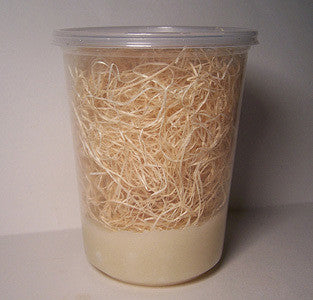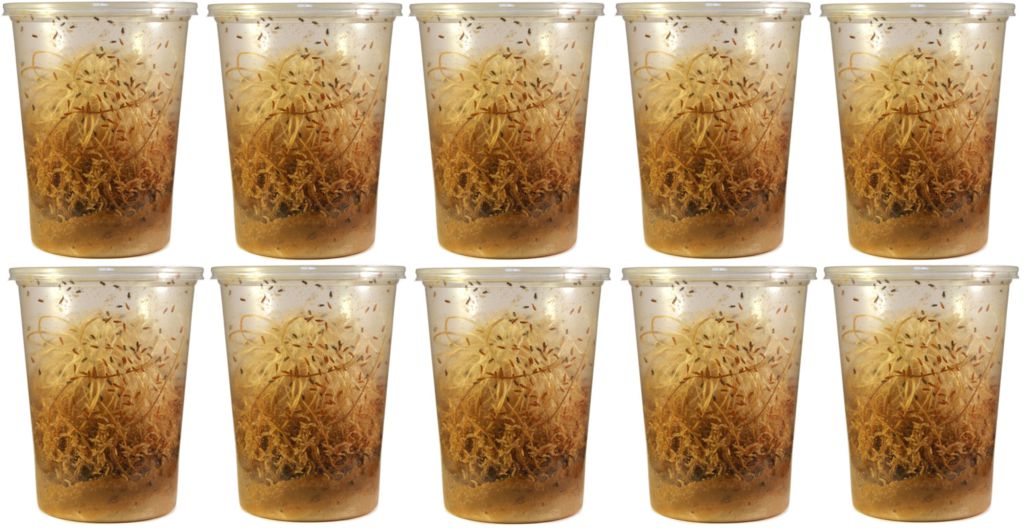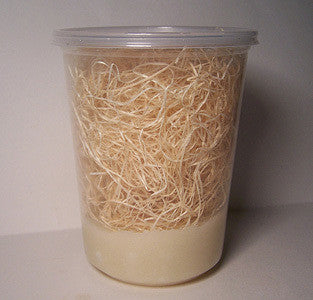

Fruit Flies Wingless Melanogaster culture
$12.50 - $110.00
This is what we feed ours, and they are great.
Drosophila melanogaster Fruit Fly Cultures should be kept at 75-78F and 60-80%. When you Receive Them, They will be 2-6 days old!
Drosophila melanogaster is about 1/16" and is the ideal food for poison dart frogs, fish, praying mantis, young frogs and toads, and other reptiles, amphibians, or captive animals that require small foods.
Our culture is grown containing vitamins, minerals, and color enhancers that make our cultures produce an amazing amount of flies!
Species:
D. melanogaster
Binomial name: Drosophila melanogaster
Common name: Common fruit fly, Vinegar fly.
This species is one of the most commonly used model organisms in biology, including studies in genetics, physiology, microbial pathogenesis, and life history evolution because they are easy to care for, breed quickly, and lay many eggs.
These fruit flies have brick-red eyes, are yellow-brown, and have transverse black rings across their abdomen. They exhibit sexual dimorphism: females are about 2.5 millimeters long; males are slightly smaller, and the backs of their bodies are darker. Males are easily distinguished from females based on colour differences, with a distinct black patch at the abdomen, less noticeable in recently emerged flies and the sexcombs (a row of dark bristles on the tarsus of the first leg). Furthermore, males have a cluster of spiky hairs (claspers) surrounding the reproducing parts used to attach to the female during mating.
The D. melanogaster lifespan is about 30 days at 29 °C
The developmental period for Drosophila melanogaster varies with temperature, as with many ectothermic species. The shortest development time (egg to adult), 7 days, is achieved at 28 °C Under ideal conditions, the development time at 25 °C is 8.5 days, at 18 °C it takes 19 days and at 12 °C it takes over 50 days. Under crowded conditions, development time increases, while the emerging flies are smaller. Females lay some 400 eggs (embryos), about five at a time, into rotting fruit or other suitable. The eggs, which are about 0.5 millimeters long, hatch after 12–15 hours (at 25 °C). The resulting larvae grow for about 4 days (at 25 °C) while molting twice (into 2nd- and 3rd-instar larvae), at about 24 and 48 h after hatching. During this time, they feed on the microorganisms that decompose the fruit and the sugar of the fruit itself. Then the larvae encapsulate in the puparium and undergo a four-day-long metamorphosis (at 25 °C), after which the adults eclose (emerge).
Females become receptive to courting males at about 8–12 hours after emergence. Males perform a sequence of five behavioral patterns to court females. First, males orient themselves while playing a courtship song by horizontally extending and vibrating their wings. Soon after, the male positions itself at the rear of the female’s abdomen in a low posture to tap and lick the female genitalia. Finally, the male curls its abdomen, and attempts copulation. Females can reject males by moving away and extruding their ovipositor. The average duration of successful copulation is 30 minutes, during which males transfer a few hundred very long (1.76 mm) sperm cells in seminal fluid to the female. Females store the sperm in a tubular receptacle and in two mushroom-shaped spermathecae, sperm from multiple matings compete for fertilization.
Introduction:
Fruit flies are the go-to feeder insect for small carnivorous pet bugs, reptiles, amphibians, and many other small pets. There are several varieties on the market but the main two are Drosophila melanogaster and Drosophila hydei. Though the care for these two species is the same, which one you choose depends on what you're feeding them to. In both cases, most of the varieties available online cannot fly like the wild fruit flies that visit your fruit basket in the warmer summer and fall months.
Fruit flies have a long history in this country as feeders and for studies in genetic inheritance in laboratories. We owe our wingless cultures of feeder Drosophila melanogaster to this science. The fruit fly is a model organism for these studies because it reproduces new generations very quickly, in as little as about 7 days. Cultures ship with adult flies usually have eggs laid in the food media at the bottom of the cage. Often, larvae are already wriggling around through the half-inch or so of food media at the time of arrival, too. Within a week, eggs hatch, larvae grow larger and then pupate (little cocoons they paste to the sides of the container), and finally fresh adults emerge from these pupae/cocoons.
Both of the commonly available species of fruit flies on the market are able to climb up the smooth surfaces of glass and plastic tanks walls.
Drosophila melanogaster are the smaller of the two popular fly species on the mainstream hobby market. These tend to be genetically modified to be apterous (completely absent of wings). They are the go-to option for the smallest carnivorous pets.
Drosophila hydei have 2 to 4 times the mass of D. melanogaster and so they are the next step up for pets that have grown just slightly too large for the D. melanogaster. Most D. hydei cultures are available for sale on the open market are genetically modified so that the musculature of the wings is inoperative. They have wings but they cannot fly. At best they can sort of hop around a little bit, making them highly attractive to your predatory pets.
Housing and Use:
Fruit fly eggs and larvae live in the moist media at the bottom of the culture, while the adult flies tend to hang out on the dry excelsior that fills the airspace in the cup. Excelsior is also known as wood wool. It consists of spaghetti-like strands of wood that Any container will do, but one that is taller than wide is recommended. A lid that opens and closes easily helps to prevent flies from escaping while you are using the culture. A container that is two to four times as tall as it is wide is best. The taller your container is in combination with the smaller the opening at the top, the fewer flies will be waiting for you at the top when you open it. Firmly tapping the bottom side of the culture down on a countertop a few times before you remove the lid will knock all the flies down to the bottom. They will crawl up in a matter of 3 or so seconds, though, and so you should be ready to open the container as soon as you tap them down, or tap them down once again. Never leave the lid off your culture. They will never feed off all the flies, or they will not continue to lay eggs to make new larvae. A fruit fly culture should last about 4 to 6 weeks, on average.
Ventilation:
All pets that are being housed in containers need some access to fresh air. A little airflow goes a long way in preventing the kind of habitat that promotes the growth of mold and even small mites that live in all households, just waiting for somebody to lay a buffet down for them. Ventilation is often achieved simply by poking small holes in a container or by cutting out a section of the lid and gluing a bit of plastic or metal screen over the opening. If you do make small holes, use pins to make the holes as this will reduce the access for mites and other pests. If you use screen, it should be of a micro-screen or fine filter variety or mites will go right through. The best lids for fruit fly cultures are poly fabric lids. These provide high ventilation while preventing access to the culture by pet bug cage pests like mites, fungus gnats or phorid flies.
Humidity Temperature
The media in your fly culture should always be in a state slightly between solid and liquid. Too wet and the adult flies get stuck in it and may drown. Too dry and the larvae can dry out or will have difficulty swimming and feeding their way through it. A little water should usually be added to the media from time to time, as it reflects a dry, too-solid appearance. In a large 32-ounce culture, a teaspoon is probably the right amount. For a smaller culture, a few drops may be all that is needed. I tend to use distilled water for all the culture I make, though tap water is generally okay.
Temperature: Room temperature is just fine for raising fruit flies. However, keeping them in the range of 75 to 83 degrees will promote faster growth and reproduction. It is especially important to ensure the media doesn't dry out in warmer conditions.
Food:
Fruit flies eat the media at the bottom of the culture. Usually, this is about half an inch deep, regardless of the size of the culture container. There are various recipes that you can create yourself. Most are based on potato flakes. Simple Google and YouTube searches will yield many recipes you can try at home. Many pre-made mixes can be purchased with long lists of beneficial ingredients. Hot water is added to this dry mix, and the anti-mold properties of these mixes, compared to many homemade mixes, are clear.
Shipping:
Fruit fly cultures are somewhat difficult to ship. The adult flies are sensitive to extreme cold and hot temperatures. Heat and cold packs are often necessary to buffer exposure. The media at the bottom has to be moist enough to support egg and larval development but not so moist that the media will spill and make a huge mess when the shipping carriers routinely turn the boxes upside down between origin and destination. In cases where this happens, and culture is a little messy, the resolution is usually as simple as turning the culture upright and tapping it firmly on a countertop a few times. Larvae and eggs are not affected by the orientation of the box. They will find the media regardless of where it might move around in the container.


